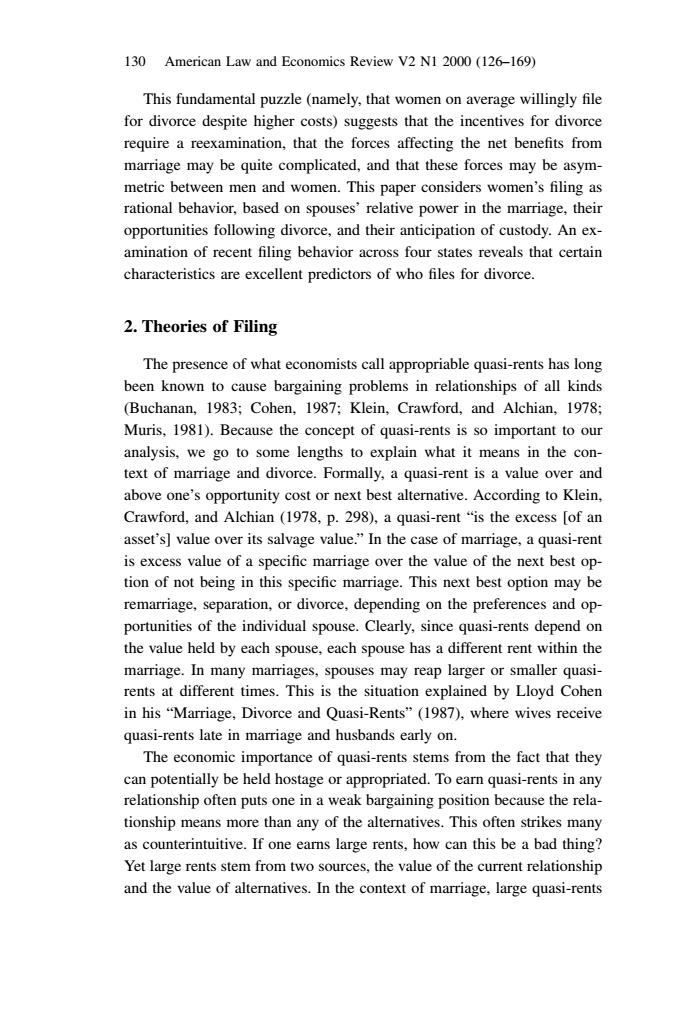正在加载图片...

130 American Law and Economics Review V2 NI 2000(126-169) This fundamental puzzle(namely,that women on average willingly file for divorce despite higher costs)suggests that the incentives for divorce require a reexamination,that the forces affecting the net benefits from marriage may be quite complicated,and that these forces may be asym- metric between men and women.This paper considers women's filing as rational behavior,based on spouses'relative power in the marriage,their opportunities following divorce,and their anticipation of custody.An ex- amination of recent filing behavior across four states reveals that certain characteristics are excellent predictors of who files for divorce. 2.Theories of Filing The presence of what economists call appropriable quasi-rents has long been known to cause bargaining problems in relationships of all kinds (Buchanan,1983;Cohen,1987;Klein,Crawford,and Alchian,1978; Muris,1981).Because the concept of quasi-rents is so important to our analysis,we go to some lengths to explain what it means in the con- text of marriage and divorce.Formally,a quasi-rent is a value over and above one's opportunity cost or next best alternative.According to Klein, Crawford,and Alchian (1978,p.298),a quasi-rent "is the excess [of an asset's]value over its salvage value."In the case of marriage,a quasi-rent is excess value of a specific marriage over the value of the next best op- tion of not being in this specific marriage.This next best option may be remarriage,separation,or divorce,depending on the preferences and op- portunities of the individual spouse.Clearly,since quasi-rents depend on the value held by each spouse,each spouse has a different rent within the marriage.In many marriages,spouses may reap larger or smaller quasi- rents at different times.This is the situation explained by Lloyd Cohen in his "Marriage,Divorce and Quasi-Rents"(1987),where wives receive quasi-rents late in marriage and husbands early on. The economic importance of quasi-rents stems from the fact that they can potentially be held hostage or appropriated.To earn quasi-rents in any relationship often puts one in a weak bargaining position because the rela- tionship means more than any of the alternatives.This often strikes many as counterintuitive.If one earns large rents,how can this be a bad thing? Yet large rents stem from two sources,the value of the current relationship and the value of alternatives.In the context of marriage,large quasi-rents130 American Lawand Economics ReviewV2 N1 2000 (126–169) This fundamental puzzle (namely, that women on average willingly file for divorce despite higher costs) suggests that the incentives for divorce require a reexamination, that the forces affecting the net benefits from marriage may be quite complicated, and that these forces may be asymmetric between men and women. This paper considers women’s filing as rational behavior, based on spouses’ relative power in the marriage, their opportunities following divorce, and their anticipation of custody. An examination of recent filing behavior across four states reveals that certain characteristics are excellent predictors of who files for divorce. 2. Theories of Filing The presence of what economists call appropriable quasi-rents has long been known to cause bargaining problems in relationships of all kinds (Buchanan, 1983; Cohen, 1987; Klein, Crawford, and Alchian, 1978; Muris, 1981). Because the concept of quasi-rents is so important to our analysis, we go to some lengths to explain what it means in the context of marriage and divorce. Formally, a quasi-rent is a value over and above one’s opportunity cost or next best alternative. According to Klein, Crawford, and Alchian (1978, p. 298), a quasi-rent “is the excess [of an asset’s] value over its salvage value.” In the case of marriage, a quasi-rent is excess value of a specific marriage over the value of the next best option of not being in this specific marriage. This next best option may be remarriage, separation, or divorce, depending on the preferences and opportunities of the individual spouse. Clearly, since quasi-rents depend on the value held by each spouse, each spouse has a different rent within the marriage. In many marriages, spouses may reap larger or smaller quasirents at different times. This is the situation explained by Lloyd Cohen in his “Marriage, Divorce and Quasi-Rents” (1987), where wives receive quasi-rents late in marriage and husbands early on. The economic importance of quasi-rents stems from the fact that they can potentially be held hostage or appropriated. To earn quasi-rents in any relationship often puts one in a weak bargaining position because the relationship means more than any of the alternatives. This often strikes many as counterintuitive. If one earns large rents, howcan this be a bad thing? Yet large rents stem from two sources, the value of the current relationship and the value of alternatives. In the context of marriage, large quasi-rents